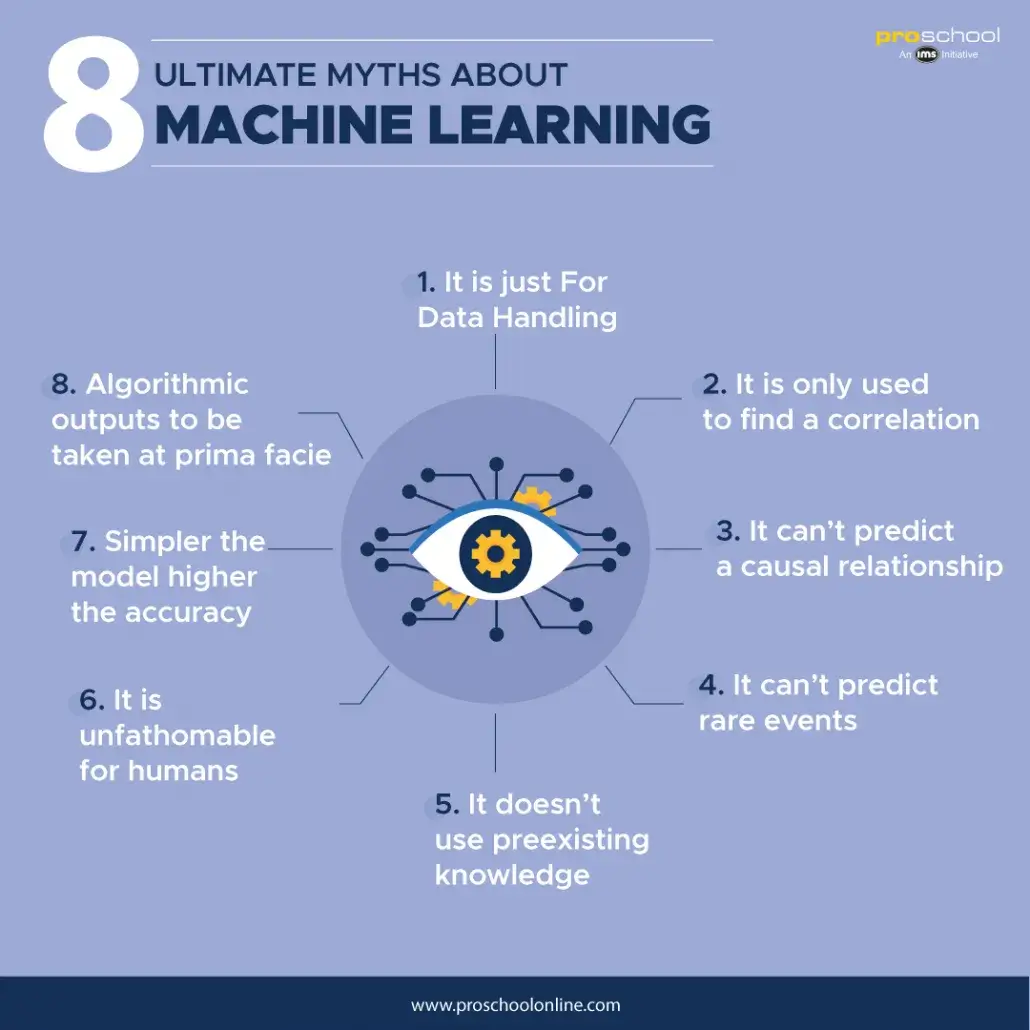8 ULTIMATE MYTHS ABOUT MACHINE LEARNING

Here's What We've Covered!
In today’s world, there is a huge buzz going around machine learning and, to be honest, a large number of people discuss it without even knowing what exactly machine learning is. Therefore, there are many myths built around the concept of machine learning and how it works. So, this article will help you to understand the concept so that you can dodge the myths in the future and are able to give useful insights during the discussions with your friends. So, let’s start.
- MACHINE LEARNING IS JUST FOR DATA HANDLING
Well, the answer is, No!! The main objective of machine learning is to forecast the most likely future events. Have you ever noticed the movie suggestions at YouTube or suggestions for purchasing products at eBay? Now, these are outputs of machine learning that analyses your activities in the past which helps it to predict what you might want to do next. These machine learning outputs are available at every corner of our life nowadays. Just like a scientist, these learning algorithms are able to formulate hypotheses, refine them and test them for validation or proof of concept. Although these learning algorithms are not as smart as scientists, their processing speed is exorbitantly quick.
- MACHINE LEARNING IS ONLY USED TO FIND A CORRELATION
You might have picked up from various media, as we all do, that machine learning is primarily helpful in establishing correlations between a pair of events. A prime example is a fact that if there is a surge in Google search for “flu” then it is an early sign that it is actually spreading. Although it is true, machine learning applications go far beyond this for more important forms of information which utilizes the past knowledge to predict a future outcome based on the correlation.
- MACHINE LEARNING CAN’T PREDICT A CAUSAL RELATIONSHIP
This is a wrong impression. As a matter of fact, one of the most popular applications of machine learning is to try out different experiments to observe their consequences, which effectively helps in predicting the cause of the desired outcome. For instance, during your online purchase, you might have come across that e-commerce sites try many different ways of product presentation to analyze which one leads to the maximum purchases. Most of us participate in thousands of such experiments without even having any clue about it. Although not always it is possible to run such experiments, and in these situations, all that the computer can do is to go through your past data to figure out the cause.
- MACHINE LEARNING CAN’T PREDICT RARE EVENTS
Have you ever been to a psychic who will foretell your future by running their fingers over a crystal ball (abracadabra)? I am not sure how well they can predict rare future events, but a machine learning algorithm surely knows the art of predicting such events with high accuracy because this is one of its major objectives. These algorithms are also able to connect two remotely connected events to draw a causal relationship for a rare unexpected event, i.e. if event A is one of the causes of event B, while event B is one of the causes of event C, a machine learning will be able to connect the dots to conclude that event A can lead to event C. In fact, the housing crash of 2008 was widely predicted based on many early signals, but it was just not picked by the flawed risk models that banks used at that time.
- MACHINE LEARNING DOESN’T USE PREEXISTING KNOWLEDGE
This is a total myth that you should avoid in the first place. There are many experts who feel that all machine learning use a “blank slate” approach of the learning algorithms. Yes, it is true that there are quite a few algorithms that use the knowledge gained as a result of the long process of reasoning and experimentation, but not all learning algorithms start with a blank slate. Some of the machine learning algorithms use pre-existing data which is refined and processed to develop a more knowledgeable database. Also keep in mind that machine learning algorithms are able to learn from previously committed mistakes, a trait that we humans beings are incapable to fathom.
- MACHINE LEARNING IS UNFATHOMABLE FOR HUMANS
Maybe this is partially true because most of the human beings are not that well versed with machine learning. Imagine if the machine learning algorithm is a black box to you, then will you be able to trust its recommendations? Luckily, it is not a black box for a large number of people who actually understand the working principle of algorithms. Although, some models are in fact very hard to understand for not-so-tech-savvy people, for instance, deep neural networks that are responsible for recognizing cats in YouTube videos. But there are quite a few models which are easily comprehensible.
- SIMPLER THE MODEL HIGHER THE ACCURACY
So, there is a widespread belief that simpler models are more accurate than the complicated ones, and the simple explanation for that may be because they are easy to understand, remember and reason. But sometimes the simplest of hypothesis with consistent data can have its own limitation as far as the accuracy for prediction is concerned as compared to the complicated model. This is the reason why some of the most powerful machine learning algorithms’ output models seem unreasonably elaborate , in fact, some of them even continue building on them after they have been perfectly applied — but that is how they differentiate themselves from the simpler but less accurate ones.
- ALGORITHMIC OUTPUTS TO BE TAKEN AT PRIMA FACIE
This again goes without saying it out loud that you have to be a skeptic when it comes to validation of a machine learning model. For instance, maybe the learning algorithmic outputs for the skin cancer diagnosis was very accurate but that doesn’t certainly mean that you should believe it without personal proofing. You should always bear in mind that a slight change in the data can result in a completely different outcome which may be equally accurate. So, the point I am trying to make here is that only those models that have induced reliable outcomes in spite of random variations in the data can be trusted, while the rest should not be until it has passed your personal validation process.
CONCLUSION
So, machine learning is more powerful than what we understand it to be and it is totally up to us what we make of it if we start with an accurate understanding of its underlying principle. Hope this article has helped you to develop a deeper understanding of machine learning.Read more about machine learning: Machine learning vs deep learning.
Resent Post
>
Which Courses After 12th Commerce With High Salary Are in Demand Worldwide?
>
How to Find ACCA Jobs Online After Qualifying: Real Portals, Tips & Career Guidance
>
Financial Modelling Classes in Hyderabad: Your Guide to the Best Institutes
>
Still Paying CFA Enrollment Fees? Here’s the Big 2026 Update!
>
How to Use myACCA Like a Pro: Dashboard, Exams, Deadlines & More!
Follow Us For All Updates!



